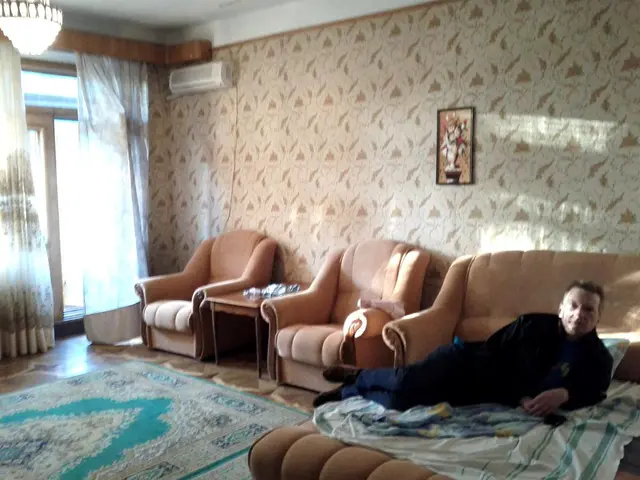Innovative Approach Worth Emulating, According to NATO Admiral: Operation Spider's Web
Crafty Tactics from Ukraine's Security Service: Spider's Web Offers Insights for NATO
Pierre Vandier, Supreme Allied Commander Transformation, has acknowledged that NATO can learn a thing or two from Ukraine, particularly from its innovative approach to combat operations, as showcased by the Security Service's Pavutyna (Spider's Web) operation.
Creative Warfare: A Blueprint for Success
According to Vandier, the Ukrainian operation was a clever strategic move that mirrors the Trojan horse tactic of ancient times. Thanks to technology and creativity, this tactic has returned in today's fast-evolving warfare landscape.
The operation serves as a testament to the importance of innovation and adaptation in winning battles. Vandier praised the operation as a smart move, suggesting that armies must not only develop grand strategic plans but also adapt them continuously in a dynamic era.
A Deeper Look at the Spider's Web
On 1 June, the Security Service of Ukraine carried out Operation Spider's Web to target Russian strategic aircraft. The operation consisted of five Russian airfields being attacked, including Olenya in Murmansk Oblast, Belaya in Irkutsk Oblast, Dyagilevo in Ryazan Oblast, Ivanovo in Ivanovo Oblast, and Ukrainka in Amur Oblast.
The strike on the Belaya airbase, located about 4,400 km from the border with Ukraine, was significant, marking Ukraine's first attack on targets in Siberia during the Russo-Ukrainian war. The primary weapons used were FPV drones, with some launched remotely from trucks to bypass Russian air defenses and surveillance.
Lessons for NATO Armies
The success of Ukraine's operation offers valuable lessons for NATO armies:
- Asymmetric Warfare: By using low-cost, mass-produced drones against high-value military assets, Ukraine achieved significant impact at minimal cost. NATO armies can learn to adopt similar tactics for penetration and disruption behind enemy lines, using drones, cyber operations, and covert logistics to weaken an adversary’s strategic assets without direct confrontation.
- Invest in AI: Integrating AI for target recognition and autonomous operations can multiply the effectiveness of drone swarms, making them more challenging to intercept.
- Long-Term Planning: Success in modern warfare requires planning across various disciplines over extended periods. This includes intelligence, logistics, deception, and technological integration.
- Exploit Civilian Infrastructure: Using civilian infrastructure for military operations can provide cover and reduce detection risks.
The implications of these lessons are profound for modern warfare:
- Shifting Power Dynamics: Smaller forces can inflict heavy damage on larger adversaries using drones and AI, undermining conventional advantages.
- Redefining Battlefields: Modern warfare is no longer confined by front lines or traditional military doctrine, as operations can strike targets far beyond a country's borders.
- Psychological and Political Effects: Such operations can erode enemy morale, provoke internal criticism, and influence negotiations.
- Vulnerability of Conventional Assets: Traditional military installations and high-value targets are increasingly vulnerable to low-cost, asymmetric attacks, necessitating new approaches to air defense, dispersal, and operational security.
Ukraine’s Pavutyna operation offers valuable insights for NATO and other modern militaries worldwide, serving as a blueprint for how to outmaneuver and degrade a stronger adversary through creativity, technology, and meticulous planning.
[1] European Pravda, https://europeanpravda.com/ru/articles/modern-world/1687122365/[2] AFP, https://fr.afp.com/[3] Ukraine World, https://www.ukraineworld.org/[4] CNN, https://edition.cnn.com[5] Defense News, https://www.defensenews.com/[6] The Guardian, https://www.theguardian.com/[7] Politico, https://www.politico.com/
- The innovative strategies employed by Ukraine's Security Service in Operation Spider's Web could provide a blueprint for NATO armies, offering lessons on asymmetric warfare, long-term planning, and the strategic use of technology in a dynamic and evolving warfare landscape, as expressed by Pierre Vandier.
- The success of the Spider's Web operation demonstrates that small forces can inflict heavy damage on larger adversaries using low-cost, mass-produced drones, such as FPV drones, thereby undermining conventional military advantages and redefining battlefields.
- Modern warfare is increasingly influenced by the psychological and political effects of creative operations that target high-value assets, bypass air defenses, and leverage civilian infrastructure, such as Ukraine's attack on the Belaya airbase in Siberia during the Russo-Ukrainian war. This necessitates reevaluating traditional air defense, dispersal, and operational security strategies.





